Glass Boxes and Jars
A National Cigar History Museum EXCLUSIVE
© Tony Hyman
Last modified: August 11, 2010

Glass Boxes and Jars
A National Cigar History Museum EXCLUSIVE
© Tony Hyman
Last modified: August 11, 2010
No one knows when the first glass cigar boxes appeared, but by the mid 1800’s they were commonly in use in Cuba, Europe and the US. This 1867 ad identifies Francis Asbury as making glass jars for the cigar trade since 1860, ten full years before tin cigar boxes were permitted.
[3660]
Glass jars may have twist top lids that close tightly with the smallest of twists as used on this, the most common amber colored glass jar. This 1900± twist top was used by F.R. Rice’s MERCANTILE cigar, a Midwestern staple for decades. All the raised letters were originally painted yellow, but less than 5% of these jars found today are still in paint, less than 1% have their labels and stamps.
[2820]
Glass jars might have odd slip top lids and their ad copy silk screened or otherwise printed directly on the glass like this 1910-1916 example.
[2819]
Glass jars also held 50 cigars with nickel plated screw lids and cut down outer labels. DOLLY DOLLARS was a role played by stage and movie actress Lulu Glaser. Cigars made in Fact. 1595, 1st Dist. PA between 1910-1915
[2889]
TYPES OF JARS AND LIDS
Glass jars might hold 10 cigars (but not often). Nickle plated screw lids are among those found on jars. The packaging cost as much as the cigars but disguised them well when wrapped as a gift.
You rarely find jars with stamps, labels, caution notices and color marks intact, especially before 1900. Jars of 25 were not common, nor were amber jars (except the one used for MERCANTILE). This jar with a zinc screw top was used by the S.R. Moss cigar Co., Lancaster, PA c1895, victim of a famous fire a decade later.
Rubber stamped postcard giving away a sample of cigars packed in glass to prove their superiority. Mailed in Michigan in 1911, a period when glass was at its height of popularity for cigar packing.
[6177]
Advertisement for clever device which permits seeing the cigars without exposing them to the elements and drying out. Two styles were offered. The one depicted used the lid of the cigar box as an easel to angle the box for display.
The second type of glass display lid holds the box lid up so it can be seen. Glass display lids could be ordered plain, etched, silk screened or with decals. FELLOW CITIZENS dates from 1919. Interesting use of Civil War imagery only one year after World War One. Sharp eyed viewers will catch something amiss in the display.
[4500]
A standard NW 50/13 but with the addition of a glass front so the cigars were visible... until of course another box was put in front of in in a cigar counter. If the cigars were visible in an unopened box, potential purchasers could see what they were getting, an advantage in that cigar companies were known to pack better cigars in the top row, not just visually better, but of different blends and leaf. c1904
[2829]
This clever attempt to provide humidification and view the cigars was patented by G.J. Johnson Cigar Co., the largest cigar factory in Grand Rapids, MI, and maker of a good many brands including GLASS TOP packed in this style box before 1900. The glass lid is inset, flush with all four sides of the box. A normal overall lid completes the box.
[2256]
A glass box with tin bottom and sides or a tin box with glass top? Take your pick. This box was used in 1916, just before WWI, but they may have been using this style for a few years before that.
When originally packed, it is likely that paper covered the cigars and was removed when the box was opened so the cigars could be seen. Note the “nail tag.” From a design standpoint, the tax stamp should have been placed on the side rather than the front where it covers the brand name.
[2831]
A glass box with tin bottom and edging, including the overall lid. Brand unknown. 1910-1915
[2832]
Punch Cigar Company in Toronto made the cigars once contained in this all glass box. What, when and why are unknown. Note the clever use of a thin piece of cedar in the bottom so the Canadian ID and CN could be printed rather than molding it into the glass (as US law required).
Hinges are glued to the top and back. Glass edges are plain on the overall lid.
[2828]
Pineapple patterned glass 50/13 box with a tin lid was used by Stickney’s SECURITY brand cigars around the turn of the century.
[3160]
The triangular notches, front on back on the lid, snap over protrusions on the glass to hold the lid in place. The ID is molded onto the back.
How and where was the Caution Notice? Caution notices, revenue stamps, and labels are frequently missing from glass boxes and jars, the result of poor adhesion or deliberately having been soaked off.
[3161]
The back of the CDV includes reasons for the superiority of glass and a complete description of this unusual and complex package set, that doesn’t seem to have caught on.
Their offer includes a bouquet of fake flowers for the centerpiece. They suggest the jars are suitable for 10¢ cigars.
[3662]
Unusual 1896 photographic CDV ad offering a five jar set to the trade for packing their cigars. Four pie-slice shaped jars held 25 each and the center could be ordered as a vase or a jar of 12 cigars.
[3661]

“Boy cigar maker” Morton Edwin ordered this to sell in his chain of stores, but this very heavy jar does not seem to have appeared in his mail order catalog. Factory ID’s were required to be molded into the glass, typically on the bottom.
[2811]
Imagine what this beauty must have cost St. Louis cigar maker and wholesaler, F.R. Rice, a packaging innovator. Look closely and you’ll see the Factory ID in the center rosette. Rice’s name is found atop the knob on this pressed glass gem of cigar packaging.
Exact date of use unknown. c1900
[2809]
According to this 1896 ad, using fancy glass jars for packaging wasn’t cheap, even at bulk rates.
[3666]
Barely 3” high, this lovely jar had a silver wash topping the raised vines. Used in the late 1880’s by Fact. 2, 5th Dist. NJ. A similar smaller jar with a gold wash and inset tin lid was used for MILO brand cigarettes.
[3364]
Eugene Valens offered their top grade of cigars in this lovely jar with a nickel plated brass top in the late 1800’s.
[2815]
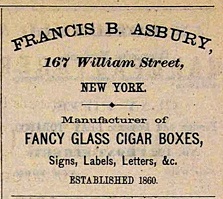
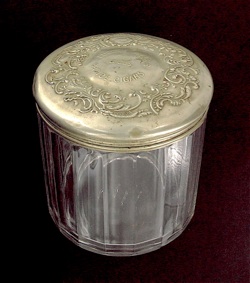
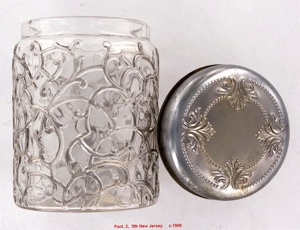

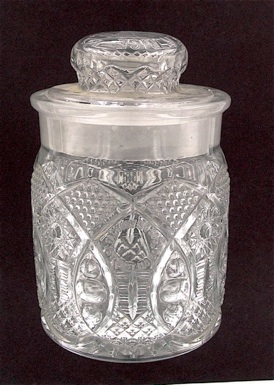
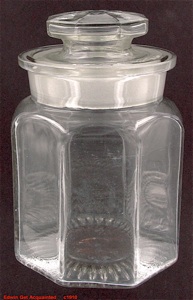
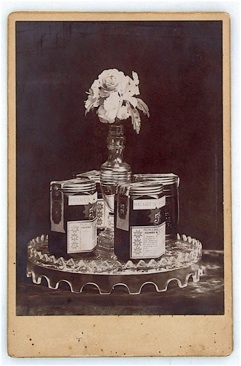
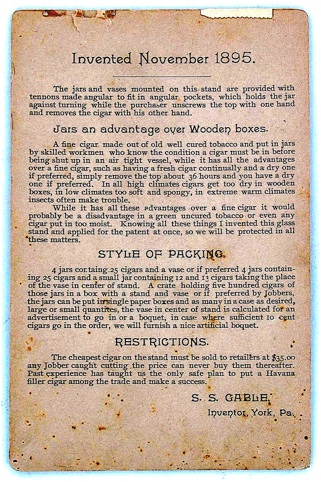
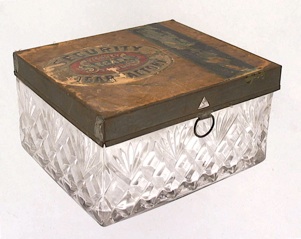
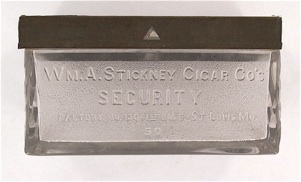
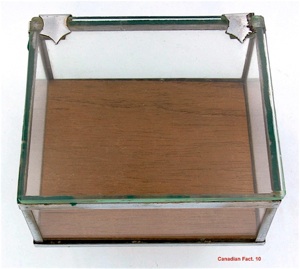


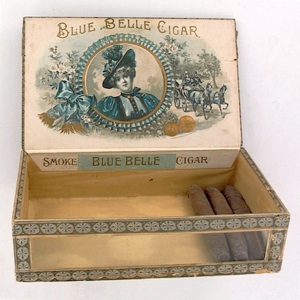
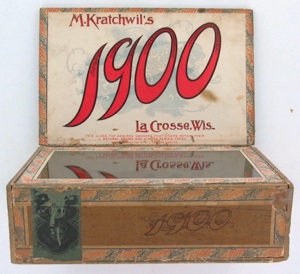

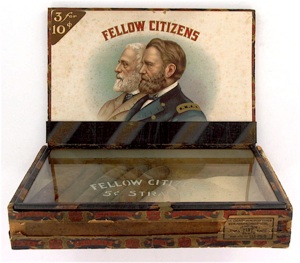
They’re not common, but uniquely shaped 50/up glass jars can be found with cardboard slip top lids and top ovals used as a label. 1901-1910
[2813]
History’s all time most common glass jar is that used by Congress Cigar Co. for its best selling LA PALINA brand during the 1920’s. Many interesting features, including the knob top held on by quickly lost metal clips.
The unique 16 sided jars were developed to help shopkeepers grip the jar after complaints began arriving. The problem was that machine age cigars were larger than hand-mades so the jar had to be larger, hence heavier, and tended to slip out of clerks’ hands and crash through glass cigar counter tops. Round LA PALINA jars are harder to find.
[2821]
LA PALINA jars also came with a useful ashtray top, with a central cigar rest that could also be used as a matchbox holder. I don’t recommend dropping them.
This is the way an original jar should look, front and back. BENSON & HEDGES and other Cuban brands used identically appointed jars.
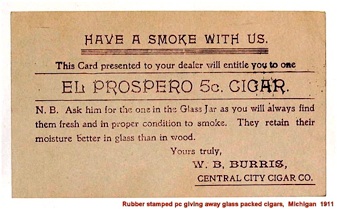
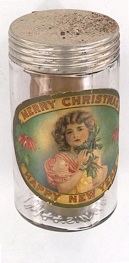
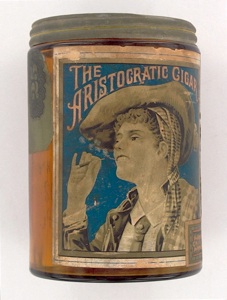
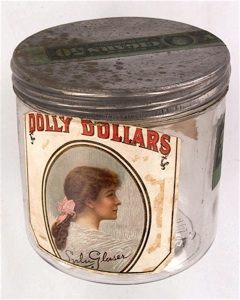
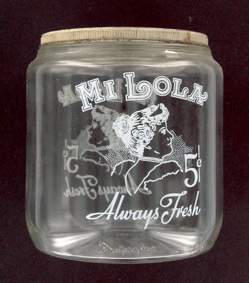


air seal so slip top lids fit tighter. The one on the left packed DUTCH MASTERS, the middle held
EL PRODUCTO, both brands with a long reputation for innovative use of glass, plastic and tin. The
EL PRODUCTO indian contained their popular Bouquet size and was packaged in a cardboard box for Christmas as “The Americana Jar.”
Beer mug cigar jar
This unusual, but very practical, 25 cigar upright was obviously reusable. May have had either a tin or cardboard lid. Smoke enuff cigars and you too could own a party’s worth of mugs.
Patented in 1907, how long it was used and by whom is unknown. This example was packed in Factory 531 in the cheap custom cigar district known as 9th PA some time before 1910 as the company is no longer listed in the 1910 cigar factory directory.
Once again, the cigar industry shows its inventive-ness long before anyone else. Laundry soap makers began packing glassware in their cartons decades later. Visit NCM exhibits of uprights and novelties
for other interesting mugs.
[9807]
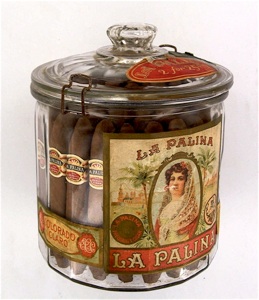

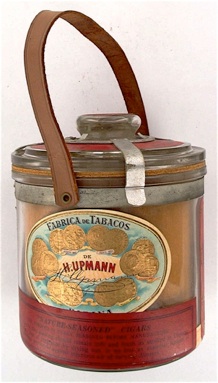
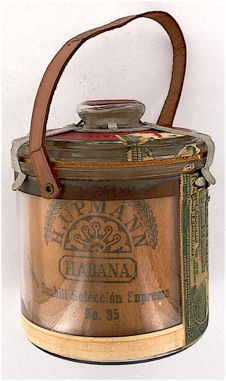
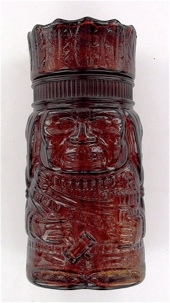
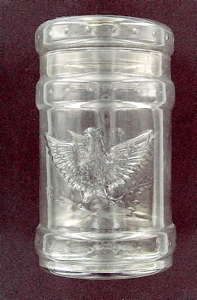
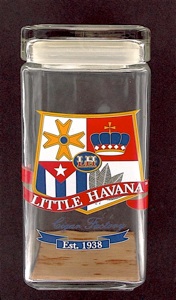

Why don’t you find tax stamps on glass containers?
The obvious answer is because someone washed them off. And in this case, obvious is probably correct, but there is more to it than that. The law, as in force in 1914, was particularly concerned that tax stamps could be easily removed from glass containers and possibly reused. It read, in part:
Retailers appear to have taken the law seriously. Jars emptied in private homes make up the majority of those that survive with tax stamps intact.
“It is therefore absolutely necessary when any package made of glass [is] emptied of the cigars originally contained therein that the stamp thereon shall be utterly destroyed under pains and penalties denounced, and if any such containers are found upon the premises of a dealer emptied, any officer of the Internal Revenue Service may destroy the same upon discovering that any portion of the stamp remains attached therein.”
This 1939 twist-top MERCANTILE jar was made by DWG in their Factory 77 in the 10th tax District of Ohio. The jar retains its stamp and yellow paint. There were no paper labels as the brand name, Caution Notice and Tax Class were painted on.
[11048]
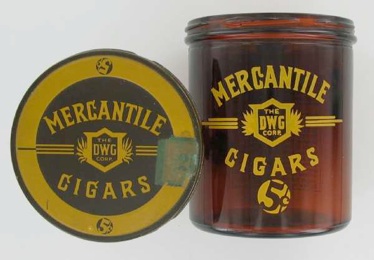
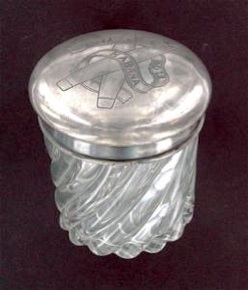


A popular travel book published in London in 1870 tells of the author’s visit to the Cabañas factory in Havana and being given a glass chest of cigars as a gift when leaving.
The jar pictured is not that gift, but is a fine example of high quality glass packing used in the second half of the 1800’s.
[2825]